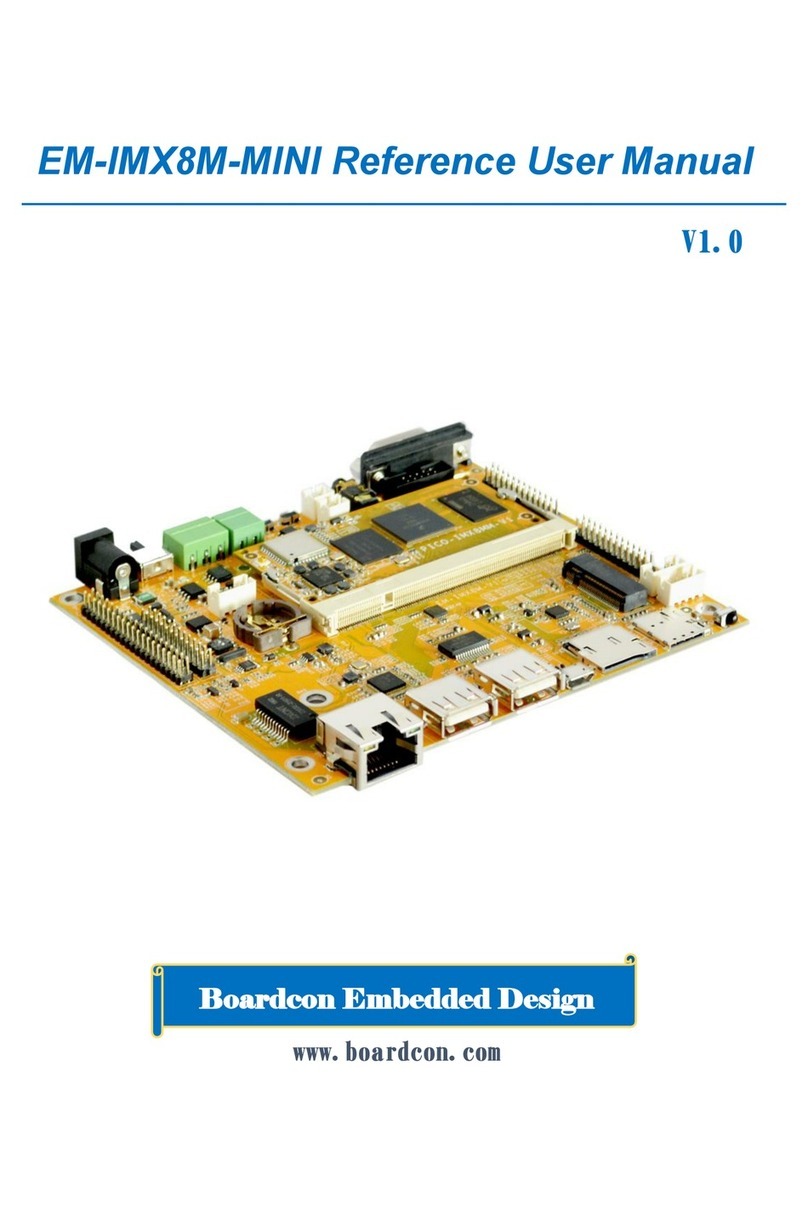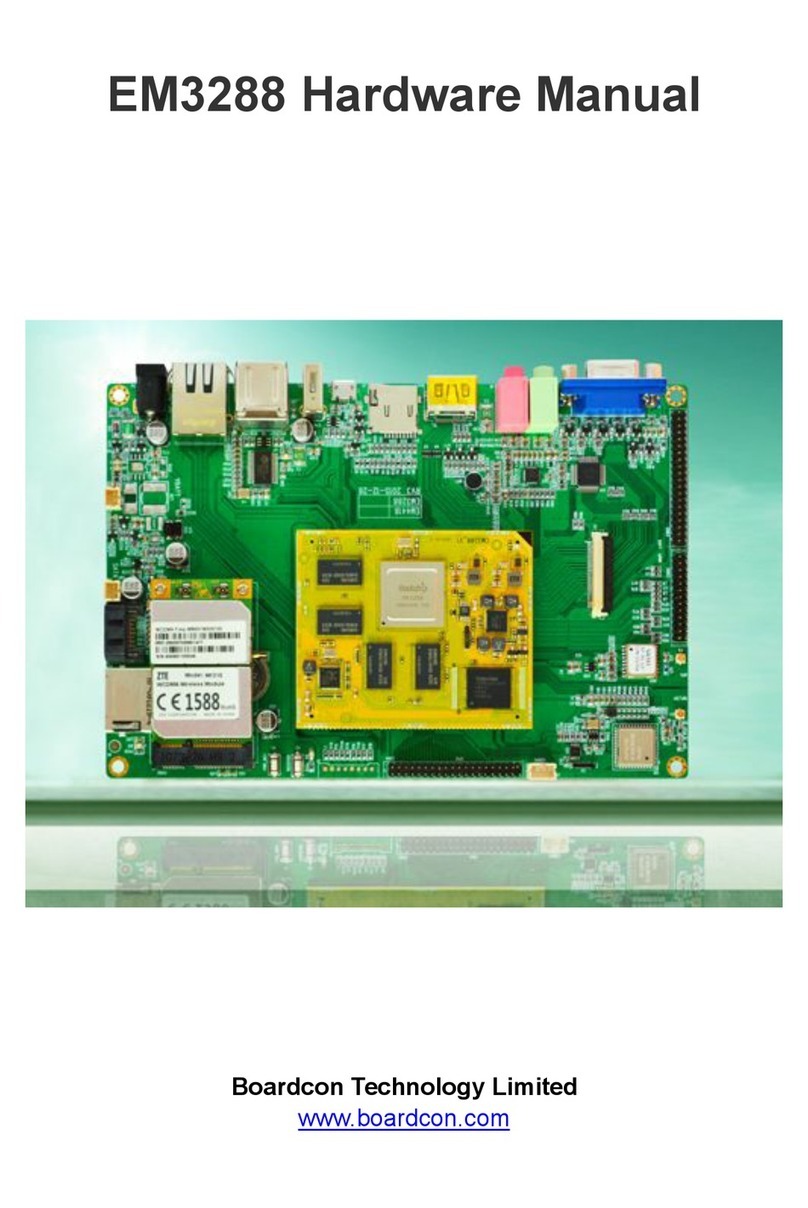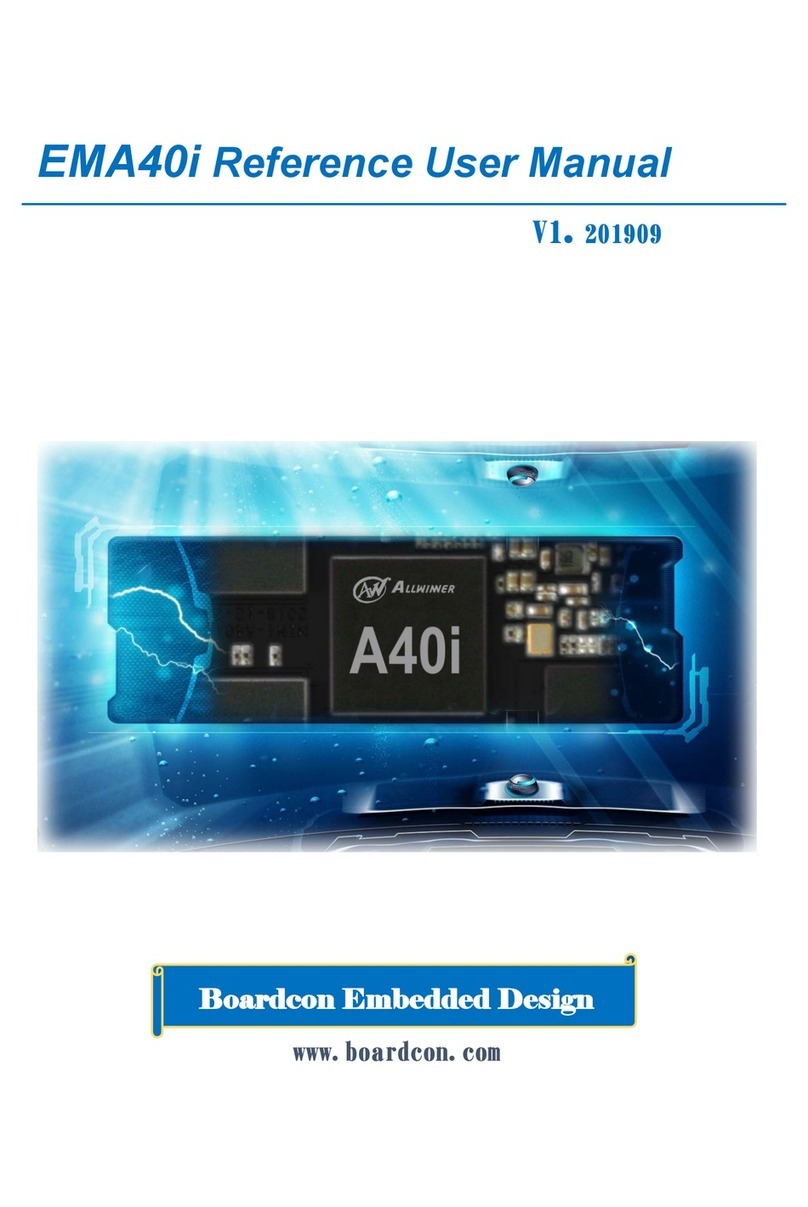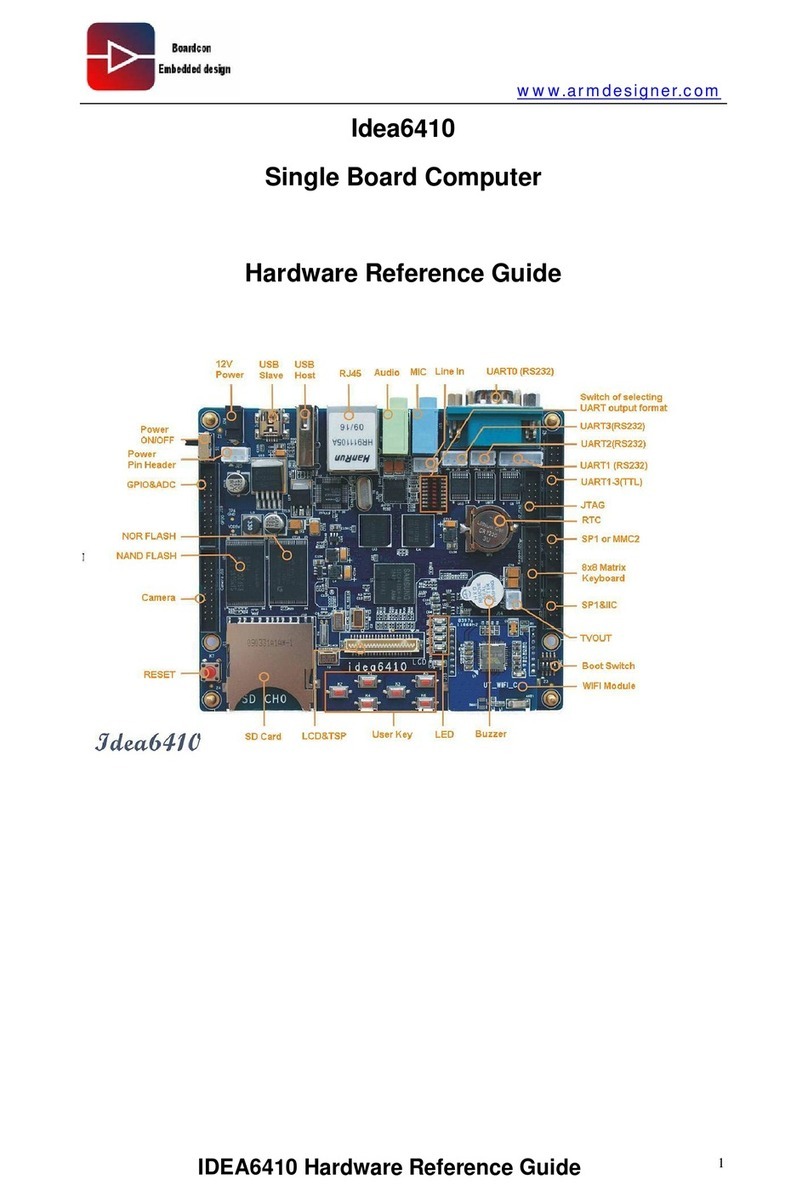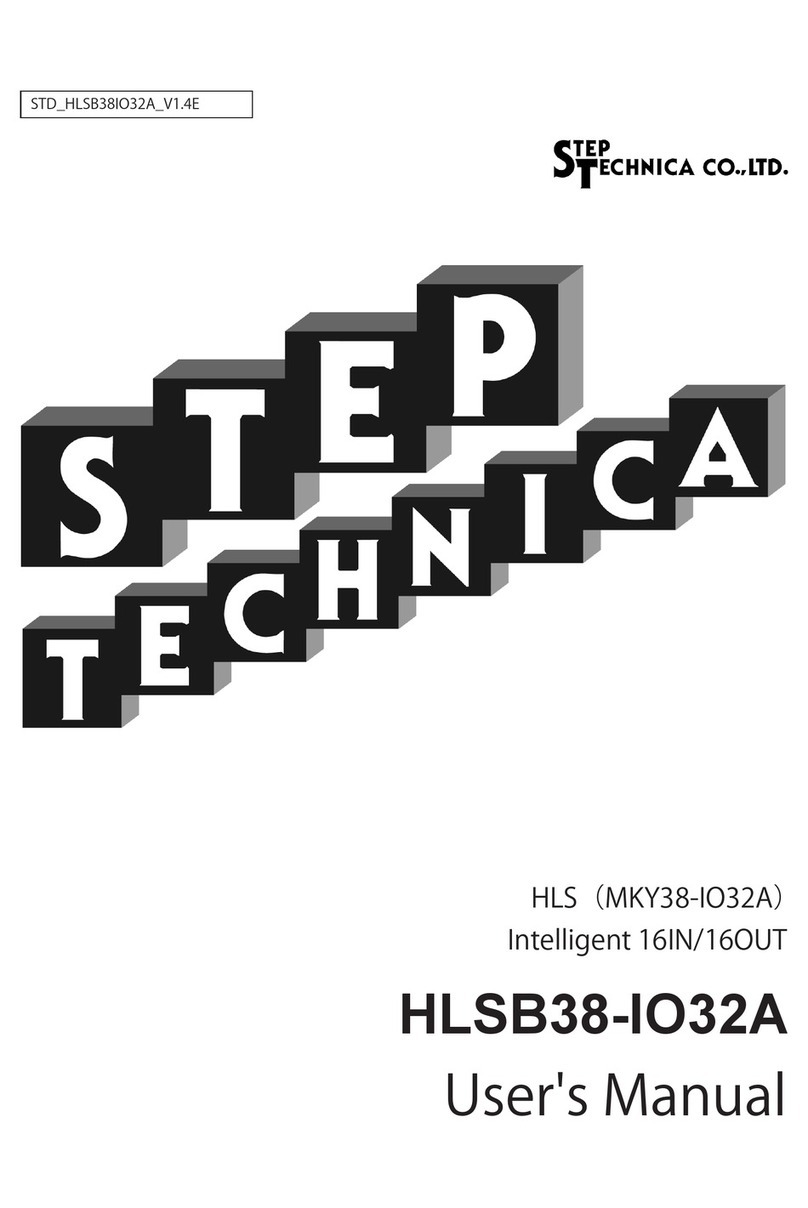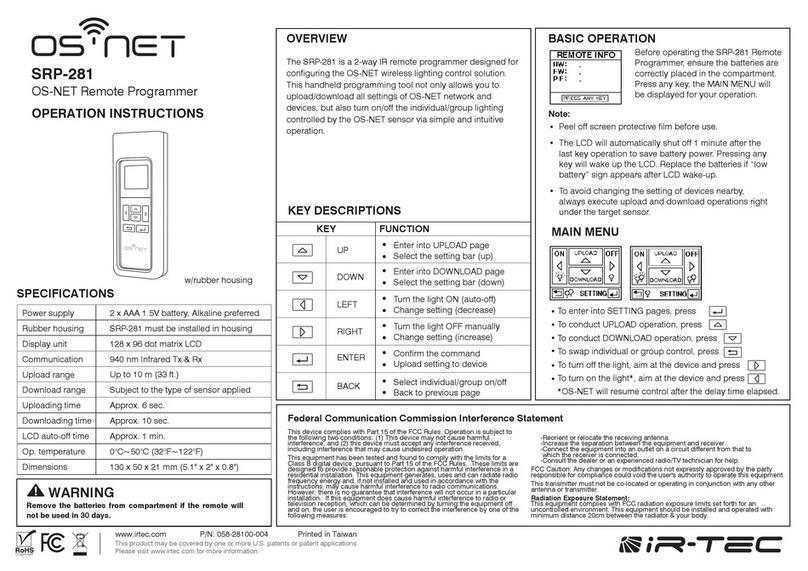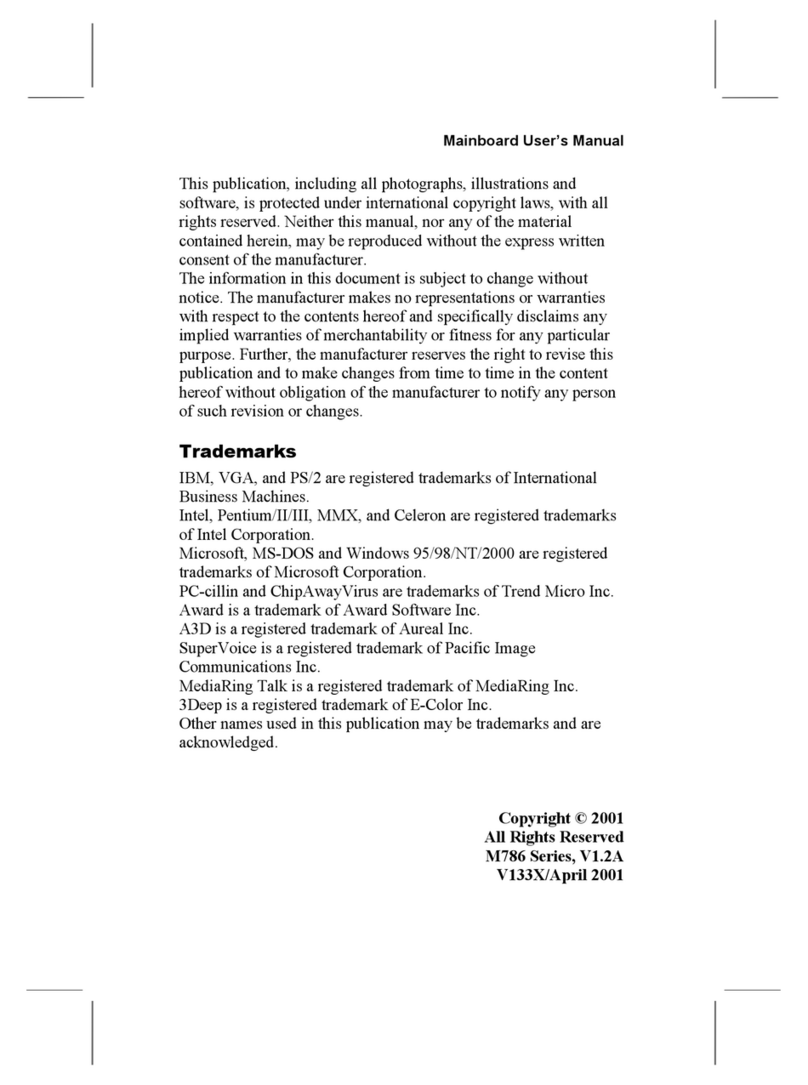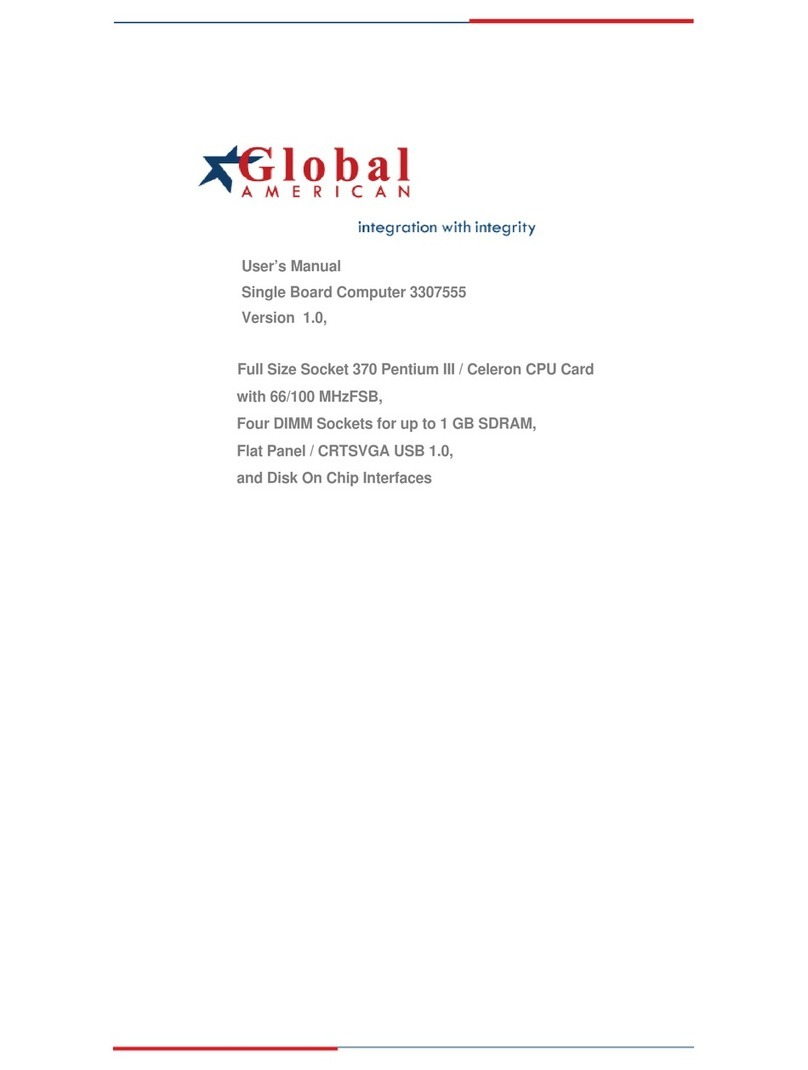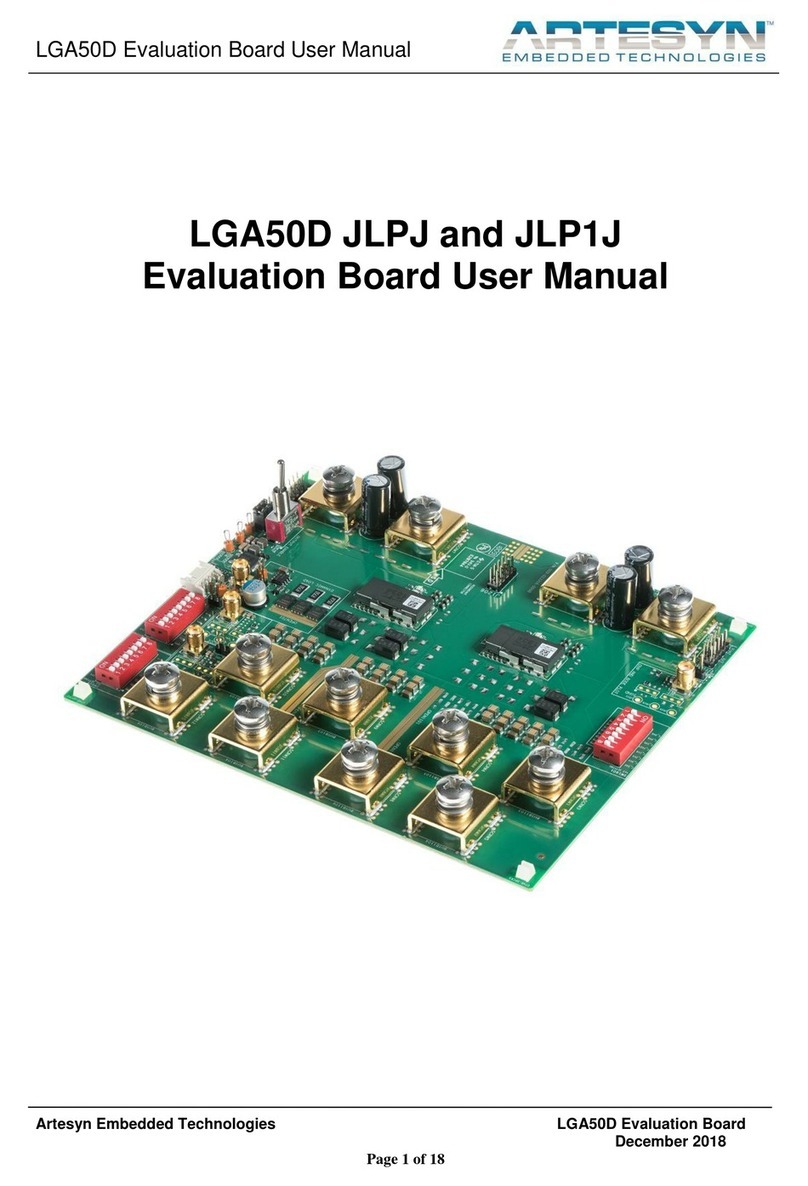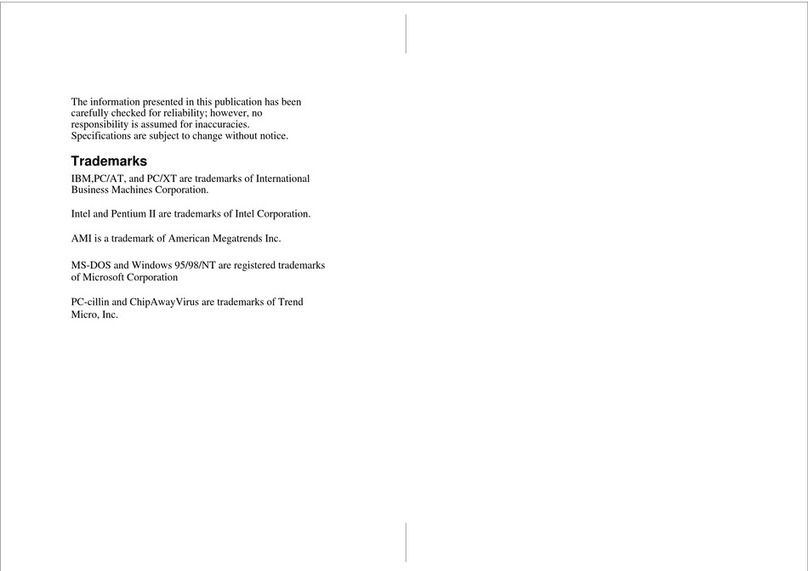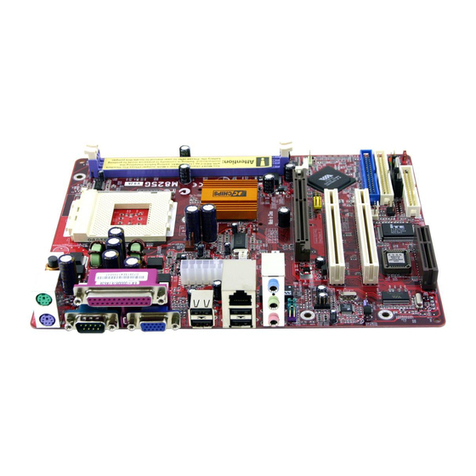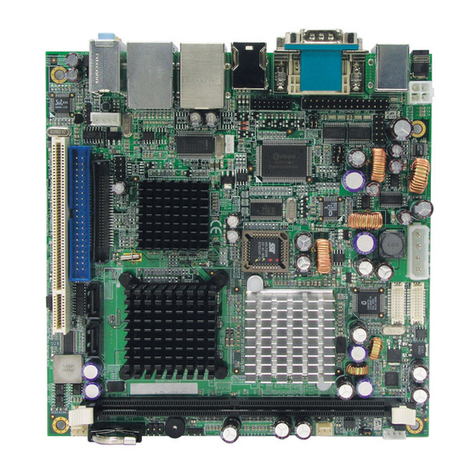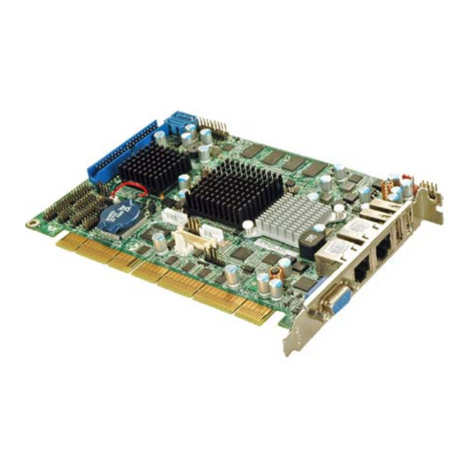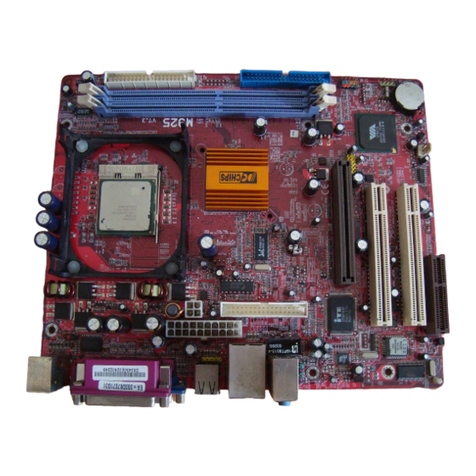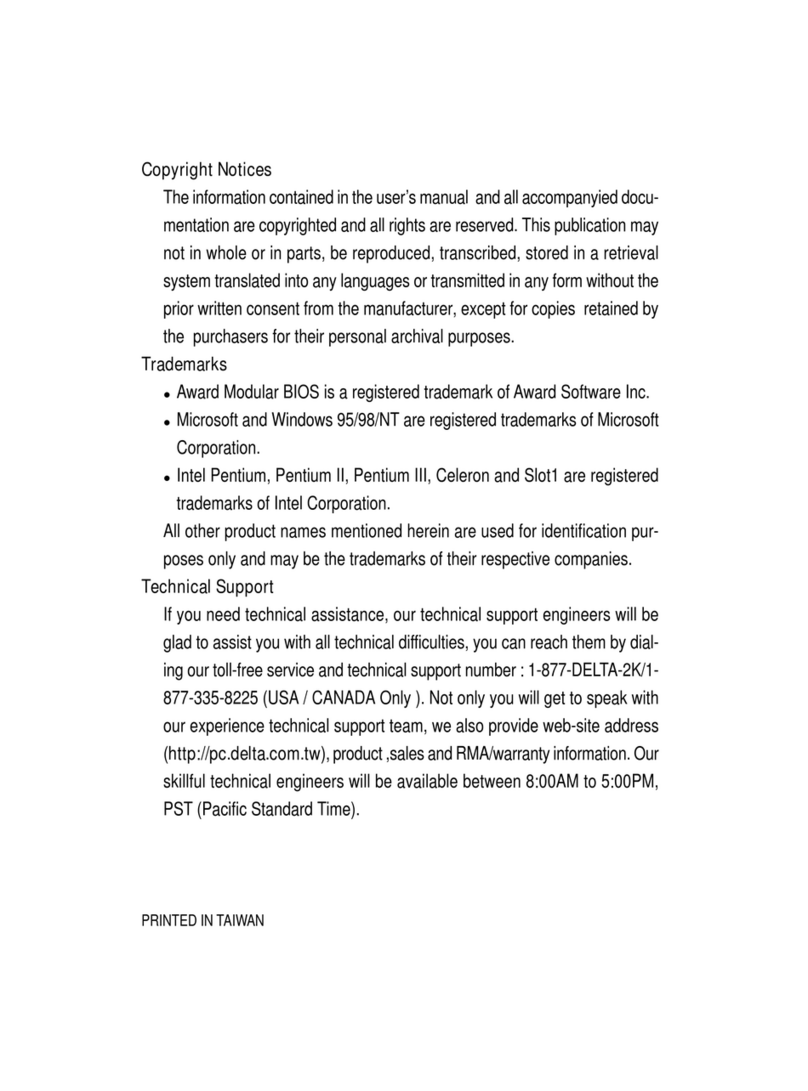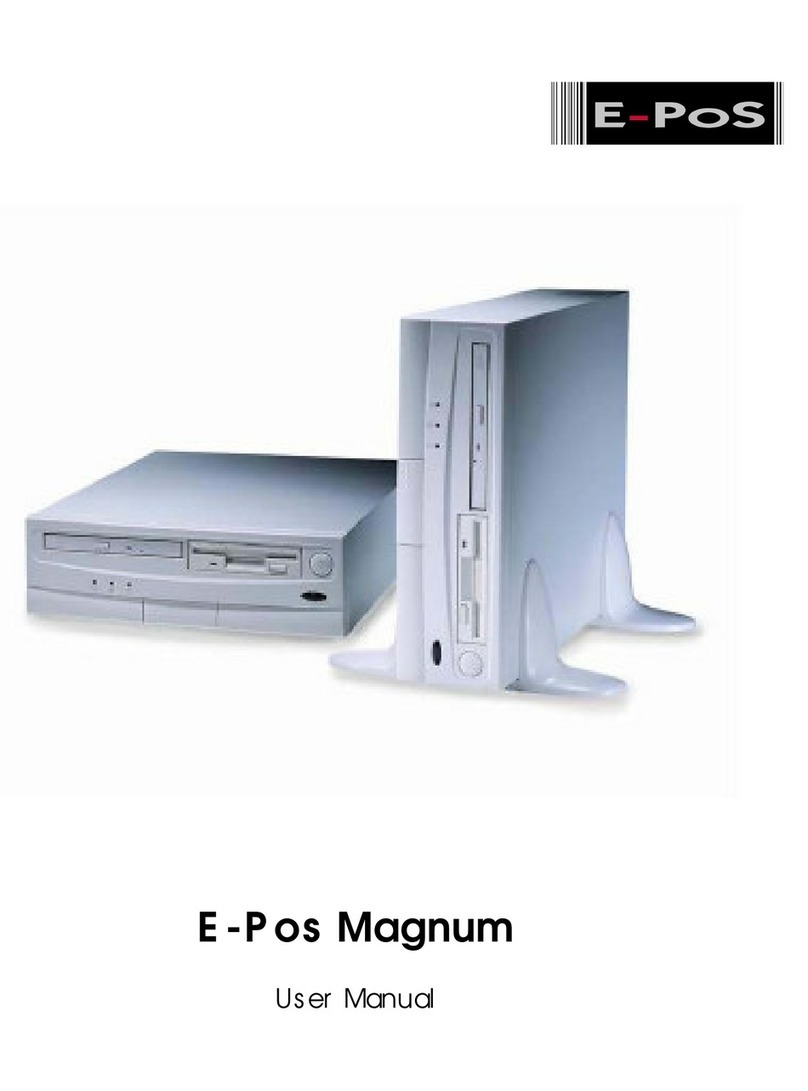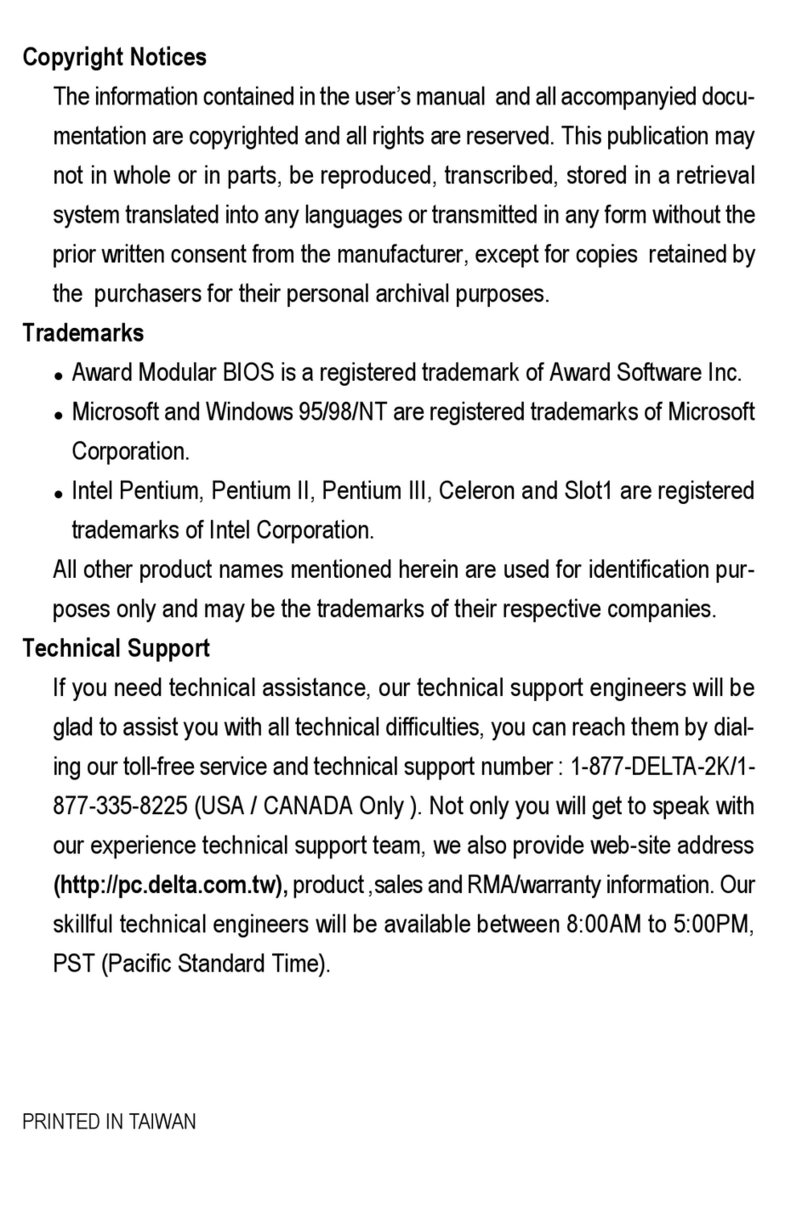Boardcon Android6410 User manual

www.armdesigner.com
Android6410 Reference Guide 1
Android6410
Single Board Computer
Reference Guide

www.armdesigner.com
Android6410 Reference Guide 2
1. Introduction
1.1. About this Manual
This manual is intended to provide the user with an overview of the board and benefits,
complete features specifications, and set up procedures. It contains important safety
information as well.
1.2. Feedback and Update to this Manual
To help our customers make the most of our products, we are continually making
additional and updated resources available on the Boardcon website
(www.armdesigner.com).
These include manuals, application notes, programming examples, and updated software
and hardware. Check in periodically to see what’s new!
When we are prioritizing work on these updated resources, feedback from customers is
the number one influence, If you have questions, comments, or concerns about your
product or project, please no hesitate to contact us at support@armdesigner.com.
1.3. Limited Warranty
Boardcon warrants this product to be free of defects in material and workmanship for a
period of one year from date of buy. During this warranty period Boardcon will repair or
replace the defective unit in accordance with the following process:
A copy of the original invoice must be included when returning the defective unit to
Boardcon. This limited warranty does not cover damages resulting from lighting or other
power surges, misuse, abuse, abnormal conditions of operation, or attempts to alter or
modify the function of the product.
This warranty is limited to the repair or replacement of the defective unit .In no event shall
Boardcon be liable or responsible for any loss or damages, including but not limited to any
lost profits, incidental or consequential damages, loss of business, or anticipatory profits
arising from the use or inability to use this products.
Repairs make after the expiration of the warranty period are subject to a repair charge and
the cost of return shipping. Please contact Boardcon to arrange for any repair service and
to obtain repair charge information.

www.armdesigner.com
Android6410 Reference Guide 3
Catalogue
1. INTRODUCTION................................................................................................................... 2
1.1. ABOUT THIS MANUAL..................................................................................................... 2
1.2. FEEDBACK AND UPDATE TO THIS MANUAL ............................................................... 2
1.3. LIMITED WARRANTY ....................................................................................................... 2
1. ANDROID6410 INTRODUCTION ......................................................................................... 7
1.1. ANDROID6410 INTRODUCTION ........................................................................................... 7
1.2. PRODUCT FEATURES ......................................................................................................... 8
2. HARDWARE SOURCES....................................................................................................... 9
2.1 MODULE BOARD INTRODUCTION ......................................................................................... 9
2.1.1 Module Board Parameter Configuration................................................................... 9
2.1.2 Picture of Module Board ......................................................................................... 10
2.1.3 Structure and Size of Module Board........................................................................11
2.1.4 Pin Sequence of Module Board...............................................................................11
2.2 DEFINITION OF MODULE BOARD PIN .................................................................................. 12
2.2.1 Definition of pin of J3 connector ............................................................................. 12
2.2.2 Definition of pin of J1 connector ............................................................................. 12
2.2.3 Definition of pin of J4 connector ............................................................................. 13
2.2.4 Definition of pin of J2 connector ............................................................................. 14
2.2.5 Pin Signal Careful Introduction ............................................................................... 15
2.2.6 Core board input voltage / current shows............................................................... 31
2.3. IMAGE OF CARRIER BOARD .............................................................................................. 32
2.3.1 Carrier board structure and layout.......................................................................... 33
3. HARDWARE DESIGN DETAILS ........................................................................................ 33
3.1. POWER SECTION ............................................................................................................. 33
3.1.1. Power input interface............................................................................................. 33
3.1.2 Power switch........................................................................................................... 34
3.1.3 Power LED.............................................................................................................. 34
3.2 START SETTING ................................................................................................................ 34
3.3. DEVICE INTERFACE DESCRIPTION ..................................................................................... 35
3.3.1. MODULE BOARD INTERFACES ........................................................................................ 35
3.3.2 UART asynchronous serial port.............................................................................. 35
3.3.3 USB HOST interface............................................................................................... 36
3.3.4. USB OTG 2.0 Interface.......................................................................................... 37
3.3.5. 100M Ethernet Interface ........................................................................................ 37
3.3.6. SD card Interface................................................................................................... 38
3.3.7. Audio Interface....................................................................................................... 38
3.3.8. TV OUT Interface................................................................................................... 39

www.armdesigner.com
Android6410 Reference Guide 4
3.3.9. LCD Interface......................................................................................................... 40
3.3.10. Four-wire resistive touch signal interface ............................................................ 40
3.3.11. CAMERA and IIC Interface .................................................................................. 40
3.3.12. Matrix keyboard interface..................................................................................... 41
3.3.13. High speed SPI and AD Interface........................................................................ 41
3.3.14. User button .......................................................................................................... 42
3.3.15 RTC....................................................................................................................... 43
3.3.16 LED User indicator................................................................................................ 43
3.3.17 Reset Button ......................................................................................................... 43
4. GPIO RESERVED............................................................................................................... 44
4.1. J7UART)..................................................................................................................... 44
4.2. J8(50PIN LCD)......................................................................................................... 44
4.3. J9(40PIN FPC LCD)................................................................................................. 45
4.4 J10.(CAMERA).......................................................................................................... 46
4.5 J12.(SDIO MODULE CH1).......................................................................................... 46
4.6. J22(SPI/AD)............................................................................................................. 47
4.7. J20(KEYPAD)........................................................................................................... 47
5. WINCE6.0 DRIVE AND INTERFACE TEST....................................................................... 48
5.1. LCD DISPLAY TEST ......................................................................................................... 48
4.3 INCH(480*272)............................................................................................................. 49
5.2. TV OUT TEST................................................................................................................. 50
5.3. NETWORK PORT TEST ...................................................................................................... 52
5.4. AUDIO TEST .................................................................................................................... 54
5.4.1. Audio Output Test................................................................................................... 54
5.5. USB TEST ...................................................................................................................... 55
5.5.1. USB HOST Interface Test...................................................................................... 55
5.5.2. USB OTG Interface Test........................................................................................ 56
5.6. SD CARD TEST................................................................................................................ 59
5.7. BUTTON TEST.................................................................................................................. 59
6. WINCE6.0 MULTIMEDIA HARDWARE CODEC TEST...................................................... 60
6.1. TCPMP PLAYER TESTING (HARDWARE DECODING)............................................................ 60
7. TEST HARDWARE ACCELERATION: FILE -> BENCHMARK......................................... 64
6.2. MEDIA PLAYER TEST(DIRECTSHOW FILTERS)............................................................... 66
6.3. RMVB PLAYER TEST....................................................................................................... 68
6.4. FLASH PLAYER TEST ..................................................................................................... 70
6.5. MULTIMEDIA TEST ........................................................................................................... 72
6.5.1. Play Movie ............................................................................................................. 74
6.5.2. Play JPEG.............................................................................................................. 75
6.5.3. Play Audio.............................................................................................................. 76

www.armdesigner.com
Android6410 Reference Guide 5
6.5.4. Test DirectShow..................................................................................................... 76
6.5.5. Test Multi Decoding................................................................................................ 77
6.5.6. Test Alpha Blend.................................................................................................... 77
6.6. 3DGRAPHICS HARDWARE ACCELERATION TEST(OPENGLES1.1&2.0)........................ 79
6.6.1. OpenGles 1.1 Test................................................................................................. 79
6.6.2. OpenGles 2.0 Test................................................................................................. 81
6.7. JPEG HARDWARE DECODING TEST ................................................................................. 81
7. LINUX DEVICE DRIVER AND INTERFACE TESTING...................................................... 84
7.1. LCD TEST ...................................................................................................................... 84
7.2. TOUCH SCREEN TEST AND CALIBRATION .......................................................................... 85
7.3. SD CARD TEST................................................................................................................ 85
7.3.1. SD card Read Test................................................................................................. 86
7.3.2. SD card Write Test................................................................................................. 86
7.4. USB TEST ...................................................................................................................... 87
7.4.1. USB Mouse Test.................................................................................................... 87
7.4.2. USB Keyboard Test................................................................................................ 88
7.4.3. U Disk Test............................................................................................................. 88
7.5. NETWORK PORT TEST....................................................................................................... 90
7.6. SERIAL TEST ................................................................................................................... 90
7.7. CAMERA TEST ................................................................................................................. 92
7.8. AUDIO TEST .................................................................................................................... 92
7.9. VIDEO TEST .................................................................................................................... 93
7.10 IMAGE VIEW TEST....................................................................................................... 93
8. LINUX FUNCTIONAL F MULTIMEDIA HARDWARE CODING......................................... 94
8.1. RUN MULTIMEDIA HARDWARE CODEC TEST PROCEDURES ................................................... 94
8.2. H264 VIDEO HARDWARE DECODING TEST........................................................................ 95
8.3. MPEG-4 VIDEO HARDWARE DECODING FUNCTION TEST .................................................. 96
8.4. H263 VIDEO HARDWARE DECODING FUNCTION TEST ....................................................... 97
8.5. VC-1 VIDEO HARDWARE DECODING FUNCTION TESTING................................................... 98
8.6. MULTI-CHANNEL VIDEO TEST HARDWARE DECODING AT THE SAME TIME ............................. 100
8.7. JPEG IMAGE DECODING HARDWARE TEST..................................................................... 101
8.8. CAMERA PREVIEW AND H264 VIDEO HARDWARE ENCODING TEST................................... 102
8.9. CAMERA PREVIEW AND JPEG IMAGE HARDWARE ENCODING TEST.................................. 104
8.10. CAMERA PREVIEW AND MFC HARDWARE DECODING TEST............................................ 105
8.11. H264 HARDWARE DECODING AND TV OUT OUTPUT FUNCTION TEST ............................ 105
8.12. MFC HARDWARE DECODING AND CAMERA PREVIEW TV OUT OUTPUT FUNCTION TEST 106
9. LINUX WEB SERVICES TEST...................................................................................................107
9.2. PING COMMAND TEST ................................................................................................... 108
9.3. TELNET FUNCTION TEST ................................................................................................ 109
9.3.1. Development telnet Linux Host....................................................................................109

www.armdesigner.com
Android6410 Reference Guide 6
9.3.2. Telnet Single Board Computer from Linux Host.........................................................110

www.armdesigner.com
Android6410 Reference Guide 7
1. Android6410 Introduction
1.1. Android6410 Introduction
The Android6410 Single Board Computer is developed based on Samsung ARM11, which
is designed to provide cost-effective, low-power capabilities, high performance Application
Processor solution for consumer electronics, industrial control, GPS, industry pda etc...
Mainly for large enterprise users to test, validate, and consult the performance of software
and hardware. Its small, fast, humanized appearance design is a best study tool for high
school, training institutions, the embedded space enthusiasts. Android6410 perfectly
realized the performance of Samsung S3C6410 in video media decoding, 2d the 3d
graphics, display and then put etc... It provides LCD interface, TV Out interface, camera
input port, 4 Serial ports, SD Card interface, SPI, 100m network Ethernet rj45 interface,
USB2. 0 - OTG interface, USB host interface, audio input and output interfaces, i2c
interface etc. it contains a higher CPU Frequency and richer peripheral, and can apply to
the embedded situation which needs higher performance and processing capacity.

www.armdesigner.com
Android6410 Reference Guide 8
Support the four operating system: WINCE6.0、LINUX、ANDROID、UBUNTU
1.2. Product Features
●Support 667MHz CPU frequency steady operation
●Support WinCE6.0 R2/R3, Linux2.6.28, android2.1 and ubuntu9.04 operating system
●Support 128M/256M DDR1 RAM
●Support MPEG-4/H.264/H263/VC-1 video coding
●Support 2D/3D hardware graphics, TV output
●Support SD/MMC/SDIO smart media card

www.armdesigner.com
Android6410 Reference Guide 9
●Support USB2.0 OTG interface download, fast upgrades system
●Support NandFlash, SD card start
●Support 4 road hige speed serial ports
●Support 4.3inch, 7inch, 10.2inch, 10.4inch or TTL/LVDS etc.
●Support Hive registry preservation
●Support SD card perfect auto upgrade system
●Support TCPMP mplayer perfect hardware decoding, support audio and vedio decoding
under resolution D1
●Support Camera echo, H264/MPEG-4 Video efficiency code
●Support MediaPlayer Video hardware decoding
●Support JPEG images hardware compiling decoding
2. Hardware Sources
2.1 Module Board Introduction
6410CV05 Module Board is a kind of high level of integration, small size, strong scalability,
low TD, high performance module board based on ARM11. Its streamlining appearance,
powerful functions, and peripheral interface make it become a best choice of vehicle
system, intelligence home, industry PDA, industrial digital control, consumer electronics, a
multimedia terminal etc.
This module board use stamp hole interface, which make its welding more fastness and
stability. The DDR1 memory which encapsulated by TSOP is more of the cost and
performance advantage,hardware support upgrade to 256M Bytes DDR1。
Development kit size: 135mm×110mm
Module board size: 52.85mm×65.55mm
2.1.1 Module Board Parameter Configuration
System configuration
CPU FREQUENCY 667MHz
DDR 128M/256M Bytes DDR1
Nand Flash 256M Bytes
Structure configuration
Appearance stamp hole character,welding fastness
Size 65.55mm×52.85mm×3mm
Pin spacing 1.27 mm

www.armdesigner.com
Android6410 Reference Guide 10
Pin pad size 1.5 mm×0.8 mm
Pin quantity 180
test point The test point is in it
Electric features
Input voltage 3.3V~5V、3V
Working temperature -10~70℃
Storage temperature -20~80℃
2.1.2 Picture of Module Board

www.armdesigner.com
Android6410 Reference Guide 11
2.1.3 Structure and Size of Module Board
2.1.4 Pin Sequence of Module Board

www.armdesigner.com
Android6410 Reference Guide 12
2.2 Definition of Module Board Pin
2.2.1 Definition of pin of J3 connector
Definition of pin of J3 connector
Pin
number signal Pin number signal
1 VDD_5V 21 SPICS1
2 VDD_5V 22 SD0_DATA0
3 VDD_5V 23 SD0_DATA1
4 VDD_IO 24 SD0_DATA2
5 VDD_IO 25 SD0_DATA3
6 VDD_ARM(NC)26 SD0_CLK
7 VDD_INT(NC)27 SD0_CMD
8 VDD_MDDR(NC)28 SD0_CDn
9 VDD_RTC 29 SD0_WPn
10 GND 30 SD1_DATA0
11 PWRRGTON(NC)31 SD1_DATA1
12 GPQ0 32 SD1_DATA2
13 OTGID 33 SD1_DATA3
14 OTGDP 34 SD1_CLK
15 OTGDM 35 SD1_CMD
16 VBUS 36 SD1_CDn
17 OTGDRV_VBUS 37 SD1_WPn
18 USBDP 38 GPE0
19 USBDN 39 GPE1
20 SPIMOSI1 40 GPE2
2.2.2 Definition of pin of J1 connector
Definition of pin of J1 connector
Pin number signal Pin number signal
41 GND 66 CSn1
42 GND 67 WEn
43 GND 68 OEn
44 GND 69 DATA0
45 GND 70 DATA1
46 GND 71 DATA2
47 GND 72 DATA3

www.armdesigner.com
Android6410 Reference Guide 13
48 GND 73 DATA4
49 GND 74 DATA5
50 GND 75 DATA6
51 ADCIN0 76 DATA7
52 ADCIN1 77 DATA8
53 nBATF(NC)78 DATA9
54 KEY_RST 79 DATA10
55 GPH9 80 DATA11
56 EINT0 81 DATA12
57 EINT2 82 DATA13
58 OM1 83 DATA14
59 OM2 84 DATA15
60 OM3 85 I2CSCL0
61 OM4 86 I2CSDA0
62 GPH6 87 CAMRSTn
63 nRESET 88 CAMHREF
64 ADDR2 89 CAMVSYNC
65 IRQ_LAN 90 CAMCLK
2.2.3 Definition of pin of J4 connector
Definition of pin of J4 connector
Pin number signal Pin number signal
91 CAMPCLK 111 TXD0
92 CAMYDATA0 112 CTSn0
93 CAMYDATA1 113 RTSn0
94 CAMYDATA2 114 RXD1
95 CAMYDATA3 115 TXD1
96 CAMYDATA4 116 CTSn1
97 CAMYDATA5 117 RTSn1
98 CAMYDATA6 118 RXD2
99 CAMYDATA7 119 TXD2
100 EINT4 120 RXD3
101 EINT9 121 TXD3
102 EINT12 122 GPH7
103 EINT1 123 GPH8
104 EINT3 124 AC97_RSTn
105 EINT5 125 AC97_SDO
106 SPICS0 126 AC97_SDI
107 SPICLK0 127 AC97_BITCLK

www.armdesigner.com
Android6410 Reference Guide 14
108 SPIMISO0 128 AC97_SYNC
109 SPIMOSI0 129 GPO2
110 RXD0 130 GPO3
2.2.4 Definition of pin of J2 connector
Definition of pin of J2 connector
Pin number signal Pin number signal
131 TSXM 156 VD7
132 TSXP 157 VD8
133 TSYM 158 VD9
134 TSYP 159 VD10
135 SPIMISO1 160 VD11
136 SPICLK1 161 VD12
137 KP_COL0 162 VD13
138 KP_COL1 163 VD14
139 KP_COL2 164 VD15
140 KP_COL3 165 VD16
141 KP_COL4 166 VD17
142 KP_COL5 167 VD18
143 KP_ROW0 166 VD19
144 KP_ROW1 167 VD20
145 KP_ROW2 170 VD21
146 KP_ROW3 171 VD22
147 KP_ROW4 172 VD23
148 KP_ROW5 173 VSYNC
149 VD0 174 HSYNC
150 VD1 175 VCLK
151 VD2 176 VDEN
152 VD3 177 PWM_TOUT1
153 VD4 178 GPE3
154 VD5 179 GPE4
155 VD6 180 DAC_OUT0

www.armdesigner.com
Android6410 Reference Guide 15
2.2.5 Pin Signal Careful Introduction
Function
Module
board
pins
Pin
description
IO
initial
state
IO
categ
ory
Worki
ng
voltag
e
Pins remultiplexing
function
Input
and
output
Function
description
1—3 VDD_5V I P 5 VDD_5V I 5V
4—5 VDD_IO I P 3.3 VDD_IO I IO
6 VDD_ARM O P
1.2/1.
3 VDD_ARM O ARM
7 VDD_INT O P
1.2/1.
3 VDD_INT O INT
8 VDD_MDD
R O P 1.8 VDD_MDDR O Memory
9 VDD_RTC I P 3 VDD_RTC I RTC
power
10 GND \ P \ GND \ 地
control 11 PWRRGTO
N O(L) hag 1.8-3.
3 PWRRGTON O
Core
voltage
control
pin
ADDR18 O
Bus
address
GPQ0 IO GPIO
GPIO 12 GPQ0 O(H
) hbg 1.8-3.
3
EINT9[0] I interrupt
13 OTGID AI hr
1.8-3.
3 OTGID I USB ID
14 OTGDP AI htr
1.8-3.
3 OTGDP IO
USB
Differenti
al data
(+)
15 OTGDM AI htr
1.8-3.
3 OTGDM IO
USB
Differenti
al data(-)
16 VBUS AI htr
1.8-3.
3 VBUS IO
USB BUS
power
17 OTGDRV_
VBUS O(L) hag 1.8-3.
3 USBDRVVBUS O
OTGpow
er supply
control
pin
USB
18 USBDP AI usb1 \ uhDP IO USB

www.armdesigner.com
Android6410 Reference Guide 16
HOST
DGPS
(+)
19 USBDN AI usb1 \ uhDN IO
USB
HOST
DGPS(-)
GPC[6] IO GPIO
spiMOSI[1] IO
SPI1 Out
from the
main
entry
20 SPIMOSI1 I hag
1.8-3.
3
EINT2[6] I interrupt
GPC[7] IO GPIO
spiCS[1] IO
SPI1
Chip
select
I2SMULTI_DO[2] O I2S SDO
SPI
21 SPICS1 I hag
1.8-3.
3
EINT2[7] I interrupt
GPG[2:5] IO GPIO
mmcDAT0[0:3] IO MMC
data
22—25 SD0_DATA
[0:3] I hag
1.8-3.
3
EINT5[2:5] I interrupt
GPG[0] IO GPIO
mmcCLK0 O
MMC
clock
26 SD0_CLK I hag
1.8-3.
3
EINT5[0] I interrupt
GPG[1] IO GPIO
mmcCMD0 IO
MMC
CMD
27 SD0_CMD I hag
1.8-3.
3
EINT5[1] I interrupt
GPG[6] IO GPIO
mmcCDN0 I
MMC
card
query
mmcCDN1 I
MMC
card
query
28 SD0_CDn I hag
1.8-3.
3
EINT5[6] I Interrupt
GPL[13] IO GPIO
hiDATA[16] IO HSI data
EINT[21] I Interrupt
SDIO
29 SD0_WPn I hag
1.8-3.
3
DATA_CF[8] IO CF card

www.armdesigner.com
Android6410 Reference Guide 17
data
GPH[2:5] IO GPIO
mmcDAT1[0:3] IO MMC
data
kpCOL[2:5] O
Column
code
30—33 SD1_DATA
[0:3] I hag
1.8-3.
3
EINT6[2:5] I interrupt
GPH[0] IO GPIO
mmcCLK1 IO
MMC
clock
kpCOL[0] O
Keyboard
Column
code
34 SD1_CLK I hag
1.8-3.
3
EINT6[0] I Interrupt
GPH[1] IO GPIO
mmcCMD1 IO
MMC
CMD
kpCOL[1] O
Keyboard
Column
code
35 SD1_CMD I hag
1.8-3.
3
EINT6[1] I Interrupt
GPN[6] IO GPIO
EINT[6] I Interrupt
36 SD1_CDn I hag
1.8-3.
3 kpROW[6] I
Keyboard
line code
GPL[14] IO GPIO
hiDATA[17] IO HSI
address
EINT[22] I interrupt
37 SD1_WPn I hag
1.8-3.
3
DATA_CF[9] IO CF card
data
GPE[0] IO GPIO
pcmDCLK[1] O
PCM
Serial
conversio
n clock
i2sCLK[1] IO I2S clock
38 GPE0 I hag
1.8-3.
3
97BITCLK I
AC97-bit
data
transfer
clock
GPIO
39 GPE1 I hag 1.8-3. GPE[1] IO GPIO

www.armdesigner.com
Android6410 Reference Guide 18
pcmEXTCLK[1] I
PCM
clock
selection
i2sCDCLK[1] O
I2S
CODEC
system
clock
3
97RESETn O
AC97
reset
signal
GPE[2] IO GPIO
pcmFSYNC[1] O
PCM
data
transfer
start flag
word
i2sLRCK[1] IO
I2S
channel
selection
clock
40 GPE2 I hag
1.8-3.
3
97SYNC O
AC97
field sync
signal
GND 41—50 GND \ P \ GND \ GND
ADC 51—52 ADCIN [0:1] AI hr 1.8-3.
3 ADC_AIN[0:1] AI
AD
conversio
n analog
input
Test 53 nBATF I hag
1.8-3.
3 nBATF I
Battery
fault
indication
Reset 54 KEY_RST I hag 3.3 KEY_RST I
Outside
reset
signal
input
GPH[9] IO GPIO
mmcDAT1[7] IO MMC
data
mmcDAT2[3] IO MMC
data
GPIO 55 GPH9 I hag 1.8-3.
3
I2SMULTI_DI I
I2S data
input

www.armdesigner.com
Android6410 Reference Guide 19
EINT6[9] I Interrupt
GPN0 IO GPIO
EINT0 I Interrupt
56 EINT0 I
hag_
a
1.8-3.
3 KPROW0 I
keyboard
line code
GPN2 IO GPIO
EINT2 I Interrupt
interrupt
57 EINT2 I
hag_
a
1.8-3.
3 KPROW2 I
keyboard
line code
Start
set 58—61 OM[1:4] I hag
1.8-3.
3 OM[1:4] I
Operatio
n mode
selection
GPH[6] IO GPIO
mmcDAT1[4] IO MMC
data
mmcDAT2[0] IO MMC
data
kpCOL[6] O
keyboard
line code
I2SMULTI_SCLK IO I2S bus
clock
ADDR_CF[0] O
CF card
address
GPIO 62 GPH6 I hag
1.8-3.
3
EINT6[6] I Interrupt
reset 63 NREST O hag
1.8-3.
3 NREST O
System
reset
output
64 ADDR2 O(L) hbg
1.8-3.
3 ADDR2 O
memory
0 address
bus
GPN[7] IO GPIO
EINT[7] I Interrupt
65 IRQ_LAN I
hag_
a
1.8-3.
3 kpROW[7] I
Keyboard
scan
code
66 CSn1
O(H
) hbg 1.8-3.
3 nCS O
Select
Memory
0
nWE O
Memory
Write
Enable 0
Bus
67 WEn
O(H
) hbg 1.8-3.
3
nIOWR_CF O Memory

www.armdesigner.com
Android6410 Reference Guide 20
0 write
enable
under IO
mode
nOE O
Memory
0 output
enable
68 OEn
O(H
) hbg 1.8-3.
3
nIORD_CF O
Memory
0 read
enable
under IO
mode
69—84 DATA [0:15] I hbg 1.8-3.
3 DATA [0:15] O
Memory
0 data
bus
GPB[5] I GPIO
i2cSCL[0] IO I2C clock
85 I2CSCL0 I hag
1.8-3.
3 EINT1[13] I Interrupt
GPB[6] I GPIO
i2cSDA[0] IO I2C data
I2C
86 I2CSDA0 I hag
1.8-3.
3 EINT1[14] I Interrupt
CAMRSTn I
Cameras
soft clear
signal
GPF5 IO GPIO
87 CAMRSTn I hag
1.8-3.
3
EINT4[5] I Interrupt
CAMHREF I
Cameras
horizontal
synchroni
zation
GPF8 IO GPIO
88 CAMHREF I hag
1.8-3.
3
EINT4[8] I Interrupt
CAMVSYNC I
Camera
field
synchroni
zation
GPF7 IO GPIO
89 CAMVSYN
C I hag
1.8-3.
3
EINT4[7] I Interrupt
CAMCLK I
Camera
mclk
GPF9 IO GPIO
Camera
90 CAMCLK I hag
1.8-3.
3
EINT4[9] I interrupt
Table of contents
Other Boardcon Motherboard manuals
